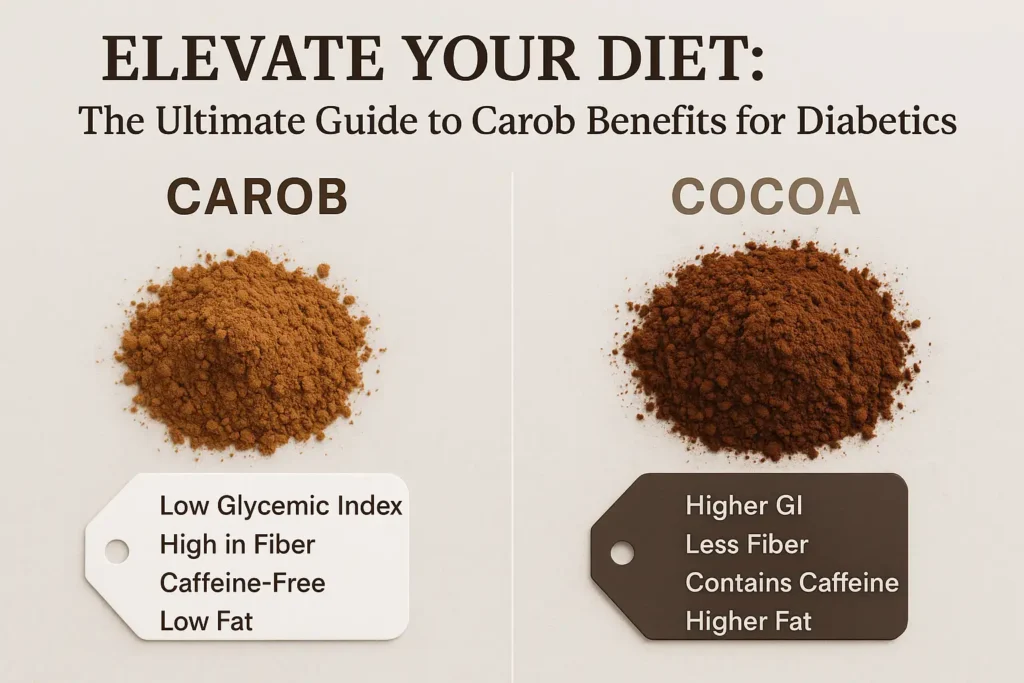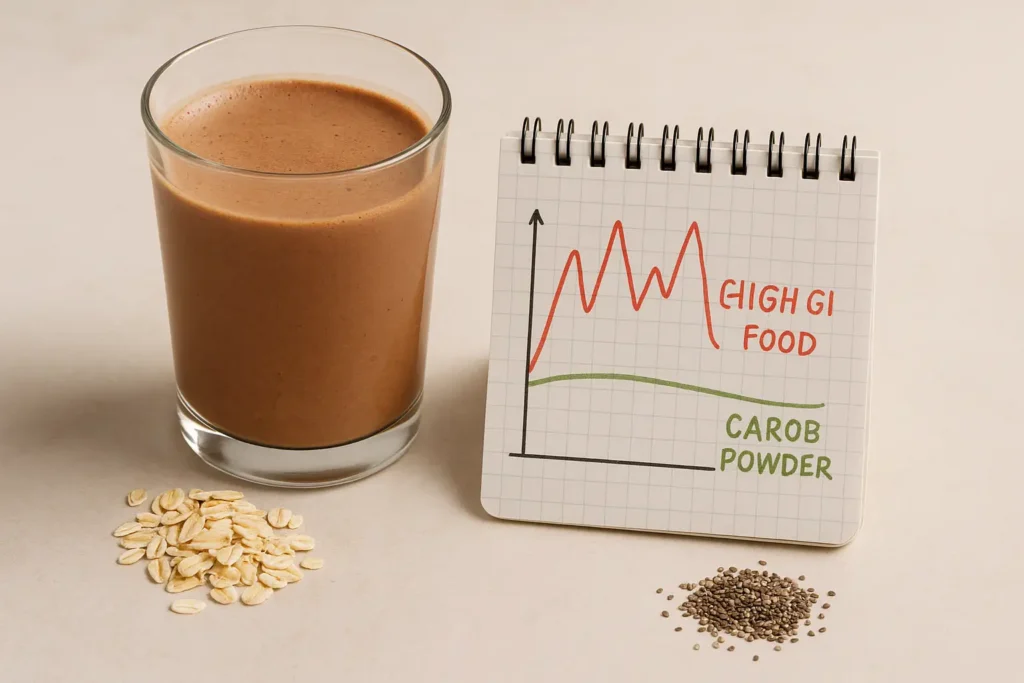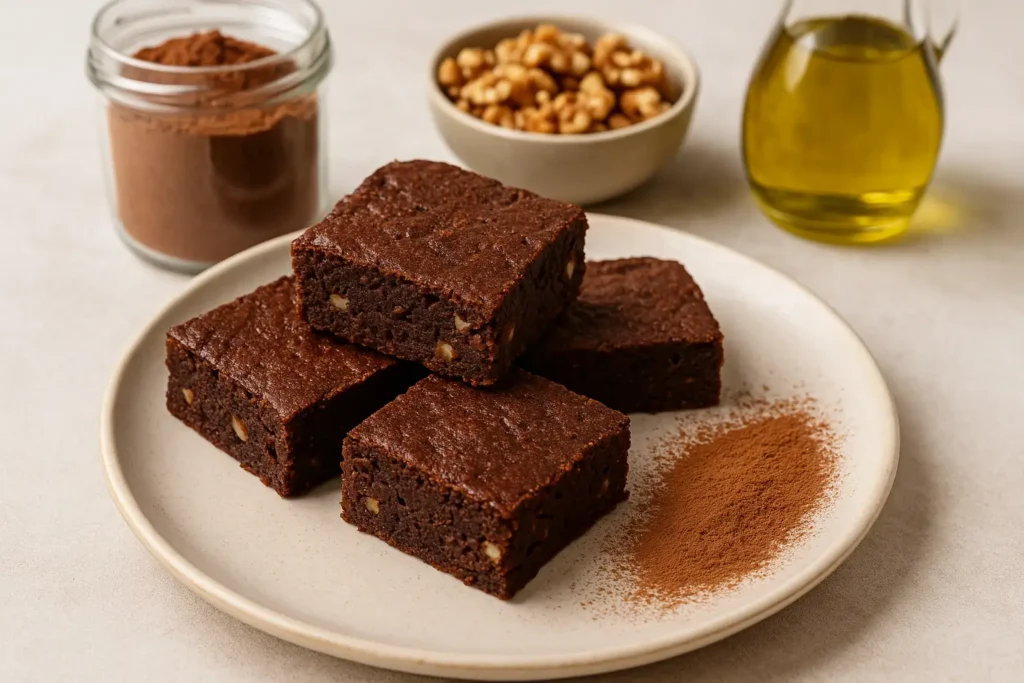Carob powder is nature’s sweet treat and a great alternative to chocolate. It comes from the carob tree, native to the Mediterranean. People have used this sweet pod as food and medicine for centuries. Carob powder is not only sweet but also rich in flavor, making it a popular choice in many dishes.
Unlike chocolate, carob powder doesn’t contain caffeine and has less fat and sugar. It’s full of nutrients like fiber, calcium, and antioxidants. If you’re looking to satisfy your sweet tooth without the guilt, carob powder is a nutritious option.
Carob powder is especially good for people with diabetes because it doesn’t cause a big spike in blood sugar levels. This is due to its low glycemic index. We’ll explore how carob powder helps with blood sugar control and can be a safe, sweet addition to any diet.
Understanding Diabetes: A Brief Overview
Diabetes is a long-term health condition where the body struggles to control blood sugar levels. It happens when the pancreas doesn’t make enough insulin or the body can’t use the insulin properly. Insulin is a hormone that manages blood sugar. High blood sugar over time can lead to serious health issues.
There are two main types of diabetes:
- Type 1 Diabetes: This is an autoimmune condition where the body attacks the insulin-making cells in the pancreas. People with Type 1 diabetes need daily insulin injections.
- Type 2 Diabetes: This is more common and happens when the body resists insulin or the pancreas can’t make enough. It often can be managed with lifestyle changes and medication.
Common Management Strategies:
Managing diabetes involves checking blood sugar levels, following your medication plan, and making lifestyle changes. These include regular exercise, keeping a healthy weight, and eating well.
The Importance of Diet in Diabetes Management:

A good diet helps control blood sugar levels, manage weight, and lower the risk of heart disease. A diabetes-friendly diet includes lots of low-glycemic foods that don’t spike your blood sugar.
Carob powder is great for diabetics because it is low-glycemic and naturally sweet. This lets you enjoy sweet flavors without adding sugars that raise glucose levels.
Nutritional Profile of Carob
Carob powder is unique because it’s not just low in calories and sugar; it’s also rich in nutrients. It has more fiber than many other sweeteners and is packed with vitamins and minerals like calcium, magnesium, and iron.
Antioxidant Properties: Carob powder contains antioxidants that help reduce inflammation and protect against stress.
High in Fiber: Carob powder’s fiber helps with digestion and blood sugar control.
Rich in Vitamins and Minerals: It has vitamins A, B2, B3, and B6, and minerals like calcium and magnesium.
Low in Fat and Calories: Carob powder is great for weight management because it’s low in fat and calories.
Carob powder and Blood Sugar Control
Carob powder is becoming well-known for helping manage blood sugar levels. It’s a natural sweetener that affects blood sugar differently than regular sugars.
Scientific Evidence: Studies show that carob powder can lower blood sugar and cholesterol, helping to manage diabetes better.
Low Glycemic Index: Carob powder’s low GI means it digests slowly, preventing quick spikes in blood sugar.
Fiber Content: The fiber in carob powder helps slow digestion, which keeps blood sugar levels stable.

Carob powder vs. Chocolate: A Diabetic Perspective
For diabetics, choosing between carob powder and chocolate can significantly impact blood sugar management and overall health.
Chocolate: It can cause quicker rises in blood sugar, especially if it’s the sugar-laden type. Dark chocolate is better but should still be eaten with caution.
Carob Powder: It has a low GI and is high in fiber, making it a better choice for controlling blood sugar.
The Role of Fiber in Carob for Diabetic Health
Carob powder’s high fiber content is excellent for managing diabetes. Fiber slows down how fast sugars are absorbed, helping prevent sudden blood sugar spikes.
Antioxidants in Carob powder: Fighting Diabetic Complications
Carob powder is full of antioxidants that help fight damage caused by high blood sugar levels. These antioxidants support overall health, reduce inflammation, and protect vital organs.
Incorporating Carob powder into a Diabetic Diet
Incorporating carob into a diabetic diet can be a delightful way to enjoy sweet flavors without compromising blood sugar control. Carob’s natural sweetness and low glycemic index make it an excellent alternative to sugar and other high-glycemic sweeteners. Here are some practical tips and ideas for adding carob to a diabetic-friendly diet:
1. Carob Powder as a Sugar Substitute:
- Use carob powder in place of cocoa powder or chocolate in recipes. It can be used in the same proportion and offers a naturally sweet flavor, reducing the need for added sugars.
- Try adding carob powder to smoothies, oatmeal, or yogurt for a touch of sweetness.
2. Carob Chips for Baking:
- Replace chocolate chips with carob chips in cookies, muffins, or pancakes. They provide a similar texture and sweetness without the sugar spike.
- Carob chips can also be a great topping for diabetic-friendly ice cream or desserts.
3. Homemade Carob Bars:
- Make your own diabetic-friendly carob bars by mixing carob powder with nuts, seeds, and a binding agent like almond butter. These bars can be a nutritious snack without the added sugars.
4. Carob Beverages:
- Brew a warm cup of carob tea as a caffeine-free alternative to coffee or hot chocolate.
- Carob milk can be made by blending carob powder with milk or non-dairy milk alternatives, offering a sweet treat without the worry of blood sugar spikes.
5. Using Carob in Savory Dishes:
- Carob’s unique flavor can add depth to savory sauces and marinades, offering a hint of sweetness without added sugar.
Recipes for Diabetic-Friendly Carob Treats:
- Carob and Walnut Brownies: A sugar-free recipe using carob powder, walnuts, almond flour, and a natural sweetener like stevia.
- No-Bake Carob Energy Balls: Combine carob powder with oats, chia seeds, peanut butter, and a touch of honey or agave for a simple, no-bake snack.
Carob for Weight Management in Diabetes
Managing weight is a critical aspect of diabetes control, and incorporating carob into one’s diet can be a strategic approach to achieving this goal. Carob’s unique nutritional profile makes it an ideal choice for those looking to manage their weight while dealing with diabetes.
Low-Calorie Sweetness: Carob is naturally sweet yet low in calories, making it an excellent substitute for sugar and other high-calorie sweeteners. For individuals with diabetes, reducing calorie intake is often a necessary part of weight management. By using carob, one can enjoy sweet flavors without the added calories that typically come from sugars in traditional sweets and desserts.
High Dietary Fiber Content: One of the standout features of carob is its high dietary fiber content. Fiber is not only beneficial for blood sugar control but also plays a key role in weight management. It promotes a feeling of fullness, which can reduce overall calorie intake by minimizing overeating and snacking. Fiber-rich foods like carob take longer to digest, keeping one satisfied for more extended periods.
Incorporating Carob into Meals and Snacks: Adding carob to meals and snacks can be an effective way to reduce calorie consumption while still enjoying flavorful foods. Here are a few ideas:
- Sprinkle carob powder on fruit or cereal for a hint of sweetness.
- Use carob chips in trail mix or as a topping for low-fat yogurt.
- Bake with carob powder as a replacement for cocoa in cakes, cookies, and muffins.
Balancing a Diabetic Diet with Carob: In a diabetic diet, balance is key. Carob can be integrated into a meal plan that includes a variety of other low-calorie, high-fiber foods to create a well-rounded approach to weight management.

Potential Risks and Considerations of Carob
While carob is a beneficial and generally safe food ingredient, especially for individuals with diabetes, it’s important to be aware of potential risks and considerations associated with its consumption.
1. Allergies and Sensitivities:
- Though rare, some people may have allergies or sensitivities to carob. Signs of an allergic reaction can include hives, itching, and gastrointestinal discomfort. Those with known food allergies should introduce carob into their diet cautiously and consult with a healthcare provider if they have concerns.
2. Gastrointestinal Effects:
- Due to its high fiber content, excessive consumption of carob can lead to gastrointestinal issues such as bloating, gas, and constipation. It is advisable to increase fiber intake gradually to allow the body to adjust.
3. Interaction with Certain Medications:
- Carob can interact with certain medications, as its fiber content might affect how drugs are absorbed in the body. Individuals on medication should consult with their healthcare provider before adding carob to their diet, especially if they are on diabetes or cholesterol-lowering medications.
4. Calorie Content and Portion Control:
- Although carob is lower in calories than many sweeteners, it still contains calories that can add up. Portion control is key, particularly for individuals managing their weight as part of diabetes control.
5. Nutrient Imbalances:
- Overreliance on any single food, including carob, can lead to nutrient imbalances. It should be consumed as part of a varied and balanced diet.
Recommendations for Safe Consumption:
- Start Slowly: Gradually introduce carob into your diet and observe how your body reacts.
- Monitor Blood Sugar Levels: Those with diabetes should monitor their blood sugar levels to see how carob affects them.
- Consult Healthcare Providers: Especially if you are on medication or have a history of food allergies.
- Balance Your Diet: Ensure that carob is part of a balanced diet that includes a variety of foods.
Expert Opinions on Carob and Diabetes
Carob, known for its natural sweetness and health benefits, has garnered attention from nutritionists and healthcare professionals, especially in the context of diabetes management. Their insights provide valuable perspectives on how carob can be effectively used in diabetic diets.
Nutritionists’ Views on Carob: Nutritionists often highlight carob’s low glycemic index, making it a safer choice for people with diabetes who need to manage their blood sugar levels. Unlike high-glycemic sweeteners that can cause rapid spikes in blood sugar, carob offers a slower release of energy. This attribute makes it a recommended option for satisfying sweet cravings without adversely impacting glycemic control.
Furthermore, the high fiber content in carob is noted for its role in promoting satiety and aiding in weight management, which is a crucial aspect of diabetes management. Fiber not only helps in controlling appetite but also in stabilizing blood glucose levels after meals.
Healthcare Professionals on Carob and Blood Sugar Control: Doctors and endocrinologists dealing with diabetes care often suggest incorporating low-glycemic index foods like carob into a diabetic diet. They emphasize that while carob is a healthier alternative to sugar and high-glycemic sweeteners, it should still be consumed in moderation. Keeping track of overall carbohydrate intake is essential for maintaining optimal blood sugar levels.
Balanced Diet and Carob: Both nutritionists and healthcare professionals agree that carob should be part of a balanced diet. They recommend combining carob with other nutritious foods rich in protein, healthy fats, and fibers to create a well-rounded meal plan for diabetes management.
Recommendations for Consumption: Experts suggest using carob powder as a substitute for cocoa powder in recipes or incorporating carob chips into diabetic-friendly baked goods. However, they caution against commercial carob products that may contain added sugars or fats, advising to always check the labels for ingredients and nutritional information.

Success Stories: Real-life Examples
Incorporating carob into a diabetic diet has been a game-changer for many individuals striving to manage their condition. Here, we share real-life examples and anecdotes of how integrating carob has positively impacted their diabetes management.
Case Study 1: John’s Journey with Carob John, a 54-year-old with type 2 diabetes, struggled with maintaining his blood sugar levels, especially given his sweet tooth. Upon a nutritionist’s recommendation, John started incorporating carob into his diet as a substitute for traditional sweets. He began using carob powder in his morning oatmeal and baking with carob chips instead of chocolate. Over several months, not only did John notice more stable blood sugar levels, but he also enjoyed the added benefit of weight loss. John’s case illustrates how a simple substitution like carob can make a significant difference in diabetes management.
Case Study 2: Maria’s Carob Discovery Maria, a 40-year-old diabetic, often found it challenging to find snacks that didn’t spike her blood sugar. She discovered carob bars, a tasty and satisfying option. These bars, made from carob powder, nuts, and seeds, became her go-to snack, providing energy without the blood sugar rollercoaster. Maria credits carob for helping her stay on track with her diabetes management while still enjoying delicious treats.
Case Study 3: The Anderson Family’s Carob Experiment The Anderson family, with a history of diabetes, decided to switch to carob-based desserts. They began experimenting with carob brownies and cookies. To their delight, not only did the entire family enjoy these healthier desserts, but their diabetic family members also saw improved blood sugar control. This change demonstrates how dietary adjustments can be both family-friendly and beneficial for specific health conditions.
Conclusion: Summarizing Carob’s Role in Diabetic Health
As we conclude our exploration into the world of carob and its role in diabetic health, it’s clear that this naturally sweet treat offers more than just flavor. Carob, with its unique nutritional profile, stands out as a beneficial addition to a diabetes management plan.
Key Benefits of Carob for Diabetics:
- Low Glycemic Index: Carob is a low-GI food, making it an excellent choice for maintaining stable blood sugar levels.
- Rich in Dietary Fiber: The high fiber content in carob aids in blood sugar regulation and promotes a feeling of fullness, assisting in weight management.
- Natural Sweetness: Carob provides a naturally sweet flavor, reducing the need for added sugars in the diet.
- Rich in Antioxidants: The antioxidants present in carob help combat oxidative stress, a common issue in diabetes.
- Weight Management: Carob’s low calorie count supports weight management strategies, a key aspect of diabetes control.
Incorporating Carob into Your Diet: We encourage readers to consider incorporating carob into their diets. Whether used as a substitute for chocolate in baking, added to smoothies, or enjoyed as a standalone snack, carob offers versatility along with its health benefits. As with any dietary change, it’s important to introduce carob gradually and observe how your body responds, especially for those with diabetes.
A Word of Caution: While carob is generally safe, it’s important to consume it in moderation and be mindful of any allergies or interactions with medications.
Resources
- PubMed (https://pubmed.ncbi.nlm.nih.gov/): A search for “carob and diabetes” on this website will yield scientific studies and research papers exploring the relationship between carob consumption and diabetes management.
- Google Scholar (https://scholar.google.com/): Similar to PubMed, Google Scholar is an excellent resource for finding academic papers. You can search for terms like “carob diabetes health” to find relevant studies and articles.
- WebMD (https://www.webmd.com/): Known for providing medically reviewed information, WebMD can be a good place to find general information about carob, its nutritional content, and potential health benefits.
- The American Diabetes Association (https://www.diabetes.org/): While it may not have specific articles on carob, this website is a valuable resource for understanding diabetes management, where you can cross-reference the benefits of high-fiber and low-GI foods.
- Healthline (https://www.healthline.com/): Healthline often has articles on various foods and their impact on health, including for those with diabetes.


4 thoughts on “The Ultimate Guide to Carob powder Benefits for Diabetics”